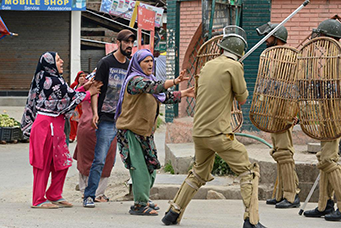



 Ken Stone
Ken StoneThe problems of Kashmir and Palestine both date back to 1947. While Palestine is well known globally, Kashmir is virtually an unknown entity. Ken Stone of the Canadian Peace Alliance thinks it ought to be brought into mainstream.
I have had the pleasure on more than one occasion of speaking alongside my colleagues in the Canadian Peace Alliance, Zafar Bangash, and also the Friends of Kashmir Committee, on the subject of the similarities between Palestine and Kashmir. The similarities are striking. Both the peoples of Palestine and Kashmir were promised self-determination by the United Nations (UN) in 1948. The Palestinians have not yet attained their state and the Kashmiris have not yet had their opportunity to vote on their preference to become part of India or part of Pakistan.
The failure of the world body, the UN, to enforce its decisions relating to Palestine and Kashmir have directly resulted in the instability of western and southern Asia, leading inevitably to military conflicts in both regions. There have been at least a half dozen major military conflicts in the Middle East in the past 70 years and many smaller skirmishes that can be linked in whole or in part to the failure to provide a homeland for the Palestinian people. Hundreds of thousands of people have died in these conflicts and millions have been injured. The toll on civilian infrastructure and people’s lives is incalculable. And the insecurity continues until today with the illegal Western aggression and humanitarian tragedy, lasting over five long years in Syria, which has been the most stalwart Arab ally of the Palestinian cause.
In South Asia, the failure of the UN to provide self-determination for the people of Kashmir has led directly to two major wars between India and Pakistan, in which there was a cumulative total of 27,150 dead and hundreds of thousands wounded on both sides.
But death and devastation are not the only consequences of the failure of the community of nations of the world to resolve the question of the self-determination of the Palestinian and Kashmiri peoples. Stunted economic growth and lack of economic development are further results of these unresolved national questions. In Palestine, the economy of the West Bank has basically stagnated over the past three decades as the Israeli government has fenced in the Palestinians with the infamous and illegal Apartheid Wall and a system of Jewish-only settlements and roads, choking the participation of West Bank Palestinians in the Israeli and other Middle Eastern economies. Official unemployment in the West Bank is at 18% but unofficially it is much higher, when the lack of participation by women and youth are taken into account.

In Gaza, which has suffered under an illegal Israeli blockade for the past ten years, unemployment is at an incredible 63%, the highest official rate in the world. All export industries have been shut down. Sparse goods trickle in through underground tunnels. Thousands are still living in tents following the last Israeli military incursion of 2014 and few students are allowed to leave to pursue their post-secondary education. In this way, the lives of Palestinians are made miserable by the illegal Israeli occupation and the life chances of Palestinian youth are reduced. A full powerpoint presentation for the UN on the negative economic consequences of the illegal Israeli occupation of the Palestinian territories was done partly by a good friend of mine, Dr. Atif Kubursi, Professor Emeritus of Economics at McMaster University and a former under-secretary at the United Nations. The document was delivered at the UN on November 15, 2015 and is a damning indictment of the illegal Israeli occupation.
In Indian-occupied Kashmir, the negative economic consequences of the illegal occupation are likewise dire. Mercy Corps, a US-based development agency, in a report in 2011 estimated 48% unemployment among Kashmiri youth (Times of India, April 16, 2016). This figure has naturally risen up considerably since, especially in view of the latest uprising from July 8. There is round the clock curfew in major cities in Indian occupied Kashmir.
There have been some studies, not as comprehensive as those of Dr. Kubursi’s, about unemployment in Kashmir such as “Employment and Unemployment Scenario of Jammu and Kashmir,” by Aasif Hussain Nengroo, Assistant Professor Department of Economics, Central University of Kashmir, Kashmir, India (Employment and Unemployment Scenario of Jammu and Kashmir).
And, apparently, it is understood that literacy levels in Pakistani-controlled Kashmir (Azad Kashmir) are higher than in Indian-occupied Kashmir while poverty rates are lower. What is needed is a comprehensive and objective report. I recommend that the government of Pakistan either demand that the United Nations produce a comprehensive report of the cost of the illegal Indian occupation of Kashmir or that it commission one itself from an independent source and make it available to the entire world.
If we compare the poverty levels, unemployment rates, the mean incomes of people in Pakistani and Indian-controlled Kashmir, the differences are stark/significant. The literacy rate in Azad Kashmir is 62% (higher than the national average of Pakistan at 45%); poverty in Azad Kashmir is similarly lower than the Pakistani national average. One reason is that many Kashmiris from the Pakistan side have settled in the UK and send remittances home. On the Indian side, the State Bank of India (2015) estimated poverty in Indian occupied Kashmir to be 10%. This however, is based on a daily income of $1.25. If we take a daily income of $2.50 or $3.00 then the rate of poverty is significantly higher.
On top of the indignity of statelessness, poverty, unemployment, and lack of opportunity; on top of the misery and destruction of war; both the Palestinian and Kashmiri people are made to suffer violations of their human rights on almost a daily basis. In Occupied Palestine, Palestinians are routinely killed almost every day. Eight thousand Palestinians, including hundreds of women and children are kept as political prisoners in Israeli jails. Armed Israeli settlers on the West Bank terrorize local Palestinians, setting fire to olive groves and farmhouses, and beating up Palestinian youth. In Gaza, Israeli jets regularly bomb civilian targets taking a steady toll of civilians and infrastructure. And I am not even counting the Israeli massacres of Palestinians in their armed incursions into Gaza of 2008, 2012, and 2014.
In Kashmir, the Indian government maintains an illegal army of occupation of over 700,000 soldiers and special police force. Since July of this year, following the spontaneous outpouring of grief by Kashmiris at the execution-style killing by Indian troops of a charismatic young militant named Burhan Wani, the Indian occupation forces have embarked on a frenzy of shootings and killings of the Kashmiris living under its illegal sway. There have been over 100 recorded deaths and at least 15,000 injuries of Kashmiris since only July 8 of this year. Many of these injuries are caused by the occupation forces firing pellet guns at crowds,, causing over 1000 eye injuries alone, to persons as young as 8 years old. Over 7600 Kashmiris have been arrested and held without charge or trial (Kashmir Media Service).
It is no wonder, then, that the Palestinians and Kashmiris resist so fiercely their illegal occupations. And, according to international law, they have every right to oppose their foreign oppressors!
In the Canadian anti-war movement, we have often employed the slogan, “From Iraq/Kandahar to Palestine, occupation is a crime!” And, indeed, most Canadians, according to respected international polling, not only know about the occupation of Palestine, but two-thirds of them generally support Palestinian statehood. Unfortunately, few Canadians have ever heard of Kashmir.
When I first learned about the Palestinian cause in the early 1970s, Israeli Prime Minister Golda Meir was still denying the existence of the Palestinian people. Israel for her was “a land without people for a people without land.” It took the hard work of at least three generations of Palestinian militants and their allies to make the Palestinian issue the single most popular cause in every corner of the world today. But the struggle for Palestine, in contrast to Kashmir, had the advantages of taking place at a strategic crossroads of Europe, Asia, and Africa; in a contested area considered holy by Jews, Christians, and Muslims; at the epicentre of the global fossil fuel industry; and as part of the post-World War Two decolonization movement.

This does not mean, of course, that the demand for self-determination of the people of Kashmir is of any lesser importance than that of Palestinians. However, it begs the question: what can we do to popularize the legitimate demand of the Kashmiri people for a referendum on their political future? How can we make the word, Kashmir, as well known as Palestine?
In the anti-war movement, we could start raising to prominence the long-standing Kashmiri question in all of our work. We could start chanting at our events, “From Kashmir to Palestine, occupation is a crime!” More important is what we could do to influence the Canadian government to raise the issue of Kashmir at the United Nations, in other international fora, and with the Indian government itself. Unlike in Palestine, where the Canadian government played a nefarious role in officially sponsoring the partition plan of 1947, and which today pays only lip service to the two-state solution for Palestine, the government of Canada has always supported the right of the people of Kashmir to a referendum to decide their political future. Unfortunately, with regard to Kashmir, Canada has largely remained silent on the issue in recent years.
Following the dark years of the Harper government, when Canada’s “unconditional support for Israel” cost us a seat on the UN Security Council, Prime Minister Justin Trudeau has served notice now “that Canada is back.” With a renewed commitment to UN peacekeeping and talks toward a climate treaty, he has signaled that Canada wishes to regain its former role as a world leader in multilateral relations and, in particular, that it is seeking a Security Council seat. When that seat is obtained, Canada will be in a position to make a difference on the issue of Kashmir.
So how can the Canadian government be persuaded to make Kashmir an issue of more prominence? Outside of the threat of a third war between Pakistan and India (both of them nuclear powers) over Kashmir, which since July has become an increasingly dangerous possibility — outside of this threat — I don’t think there is a magic bullet. In liberal democracies, such as Canada, governments grudgingly respond to grassroots public pressure. There are a lot of people of Pakistani origin in this country. There is, in addition, a large and growing Muslim community in Canada. If these Canadians, plus people in the peace movement, and persons of conscience generally, were to start to undertake the nitty-gritty work of visiting their MPs on an annual basis, of writing letters and op-ed pieces for local newspapers; were to start creating websites and using social media; were to raise the issues in local unions, in mosques and other places of worship; were to hold the occasional public meeting, then slowly but surely the issue of Kashmir would take on a greater profile in Canadian political life. The government of the day could not afford to ignore it. Kashmir would have to become a more important issue for Canada at the UN, in other international arenas, in military relations with other countries, and in trade talks.
I think we also need to talk about the costs of occupation — to the occupiers and their supporters. In Palestine, the confinement of the Palestinian people in the world’s largest open-air prison, Gaza, and their restriction to tiny little Bantustans on the West Bank costs the Israeli government billions of dollars a year in equipment and personnel. In fact, the illegal Israeli occupation could not be continued without the annual infusion of $3 billion in US aid per year, plus the money raised in countries such as Canada through donations to the Jewish National Fund and State of Israel Bonds. Besides the utilization of enormous financial and manpower resources, the occupation has turned Israel into an ugly apartheid regime that treats even Palestinians with Israeli citizenship as second or third class citizens. Many Israeli Jews of conscience have voted with their feet and emigrated back to Europe and North America.
In Kashmir, the Indian army of occupation consists of over 700,000 soldiers and police. How much does that army cost the Indian state each and every year? What if the money required to support that army were used instead to provide some relief for the 400 million Indians who live in abject poverty, year after year? What if those 700,000 men were gainfully occupied in India in agriculture or industry? What would that do to India’s gross domestic product?
The time has come to put all these questions to the Canadian public. I look forward to being a part of this public debate. I thank the Friends of Kashmir Committee for organizing this important event. Thank you!
Ken Stone is a member of the Canadian Peace Alliance. He presented this talk at the Kashmir Solidarity Conference in Toronto on November 5, 2016.
